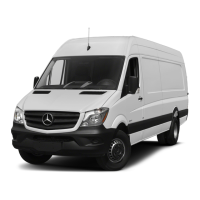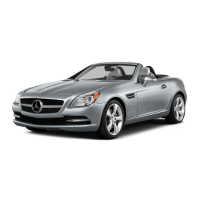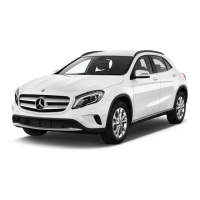Problem
Possible causes/consequences and M Solutions
The engine does not
start.
The starter motor cannot
be heard.
The on-board voltage is too low. The battery is too weak or discharged.
X
Jump-start the vehicle (Y page 242).
If the engine cannot be jump-started, the starter motor is faulty.
X
Consult a qualified specialist workshop.
The engine does not
start.
The starter motor cannot
be heard.
The battery is discharged or faulty.
X
Check the battery for damage.
X
Charge the battery (Y page 232).
Automatic transmission
Important safety notes
G
WARNING
If the engine speed is above the idling speed
and you engage transmission position D or R,
the vehicle could pull away suddenly. There is
a risk of an accident.
When engaging transmission position D or R,
always firmly depress the brake pedal and do
not simultaneously accelerate.
!
Vehicles with automatic transmission may
roll only briefly in the neutral position N. Pro-
longed rolling of the wheels, e.g. when being
towed, will result in transmission damage.
Towing (
Y page 243)
Selector lever
j
Park position with parking lock
k
Reverse gear
i
Neutral
h
Drive
The display in the instrument cluster shows the
present selector lever position or the current
shift range:
R
on vehicles with steering wheel buttons
(
Y page 167)
R
on vehicles without steering wheel buttons
(
Y page 163)
Selector lever positions
B
Park position
This prevents the vehicle from rolling
away when stopped. Only move the
selector lever to P if the vehicle is
stationary.
You can only remove the key when
the selector lever is in this position.
The selector lever is locked in posi-
tion P if the key is removed.
The parking lock should not be used
as a brake when parking. Always
apply the parking brake as well once
you have parked the vehicle.
C
Reverse gear
Only move the selector lever to R
when the vehicle is stationary.
124
Automatic transmission
Driving and parking

